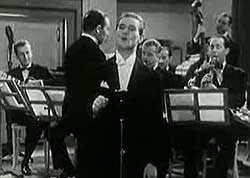 Occasionally jukebox soundies originated as clips from musical shorts rather than newly made as soundies. Such as those can frequently be recognized as having been converted to jukebox soundies (as opposed to just being randomly preserved three-minute clips) because they are printed backward for the rear-projection of panoram jukeboxes.
Occasionally jukebox soundies originated as clips from musical shorts rather than newly made as soundies. Such as those can frequently be recognized as having been converted to jukebox soundies (as opposed to just being randomly preserved three-minute clips) because they are printed backward for the rear-projection of panoram jukeboxes.
This happened especially with films directed by Al Christie for E. W. Hammon's company Educational Pictures. From 1915 to 1939, the company made everything from short silent comedies to musical short subjects, featuring everyone from Buster Keaton to Roy Rogers.
The roster of singers, comics, & actors who debuted in Educational Film short subjects is a who's who of the era -- Shirley Temple, Bob Hope, Bing Crosby, Danny Kaye, the Ritz Brothers, ad infinitum, although a lot of the library unfortunately lost in a 1937 warehouse fire.
Then the company went bankrupt & the film library (mostly of musicals which escaped the fire) was auctioned off in 1940. Those purchased by panoram companies were reduced to three-minute bites to be recycled to the public in jukeboxes.
One such backward print features bland crooner Lee Sullivan was excerpted from Air Parade (1938) recycled as Once in a While; aka, Soundie P (1941). The lyrics of the bridge run: "In love's smoldering ember/ One spark may remain/ If love still can remember/ The spark may burn again."
Though Sullivan doesn't do a lot with the song, it's not a bad one, & such singers as Nat King Cole & Patti Page did finer versions.
It was written by Michael Edwards & Bud Green. Green had started out as a vaudeville & ragtime songwriter in the '20s, & was snatched up to write for Hollywood musicals in the '30s & '40s. Edwards was more of a musical arranger & wrote only a few songs, either with Bud Green or Gladys Shelley.
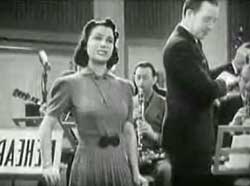 Throughout the love tune, a beautiful woman sitting on the edge of the stage in front of the orchestra gives moony gazes at Sullivan. She is Niela Goodelle, who was separately excerpted from the same short subject to get a second soundie, Ten Pretty Girls; aka, Soundie M (1941). There is more excerpt from Air Parade which became Radio Parade (1943), featuring Niela Goodelle. Throughout the love tune, a beautiful woman sitting on the edge of the stage in front of the orchestra gives moony gazes at Sullivan. She is Niela Goodelle, who was separately excerpted from the same short subject to get a second soundie, Ten Pretty Girls; aka, Soundie M (1941). There is more excerpt from Air Parade which became Radio Parade (1943), featuring Niela Goodelle.
Apart from all the left-handed musicians who of course weren't left handed at all, Ten Pretty Girls is instantly recognized as a soundie retread, given away by a sign by the stage that says "Rehearsal" in Reversal.
Niela is holding her sheet music as she sings. It's rather a charming odd number rendered all the more amusing by the affected over-trained manner by which it is sung, with the catchy ring of an old vaudeville number, though written in 1937 by Wilhelm Grosz & Jimmy Kennedy.
That songwriting team is best remembered for "Red Sails in the Sunset," though Kennedy also wrote the lyrics to one of the most incredible novelty songs of all time, "The Teddy Bears' Picnic," which had previously been only an instrumental by J. W. Bratton.
Ten Pretty Girls goes in part: "There were ten pretty girls at the village school/ Picture ten village belles at the village school/ Cute & sweet, short & tall/ And the boys loved them all/ But you can't marry ten pretty girls."
Soundies for jukebox play were two & a half to three minutes in length, but "Ten Pretty Girls" takes only a minute & a half to sing, so a second equally short song is included.
"If It's the Last Thing I Do" is a more serious swing tune, written by Sammy Cahn & Saul Chaplin. "Darling the last thing I'll do is make you mine/ Darling the first thing is you in my design." It's quite nicely sung.
Between the two numbers there is a jumpcut to a radio radiogram console (combination radio & record player) that seemd rather out of place with the exerpts having lost some of the context.
In its entirety Air Parade was set in a radio station, a two-reel musical comedy with a full cast. Niela Goodelle played Lady Alice, who had a children's program on the radio, but wants a serious singing career. She & her friend Lee convince the radio station to let them Put On A Show.
Among the performers are the comedy team of Haver & Lee, with lines like: "Do you have a fairy godmother looking over you?" "No, but I have a sissy uncle." Their routines are still funny after all these decades & they pretty much steal the film.
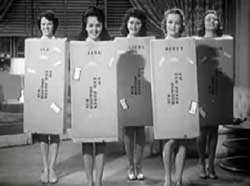 Gags & Gals (1941) is three-films-in-one. It's an odd-ball one-reel Vit-o-Graph production, a competitor with the Mills Panoram jukebox. Althoug it didn't actually originate as a Panoram Jukebox though it looks just like a set of soundies. It was also distributed to the home-movie market by Official Films.
Gags & Gals (1941) is three-films-in-one. It's an odd-ball one-reel Vit-o-Graph production, a competitor with the Mills Panoram jukebox. Althoug it didn't actually originate as a Panoram Jukebox though it looks just like a set of soundies. It was also distributed to the home-movie market by Official Films.
The overall title of this set of three wasGags & Gals which was surely an afterthought for films initially titled separately, & retaining the individual title cards throughout.
Whether lumped together in groups of six or seven for Panoram play, or groups of three for theatrical or home-release, commercial reality was that the whole reel should appeal to the same sort of persons or they wouldn't want to plunk in nickels to see the ones in front of the title they were most interested in viewing.
Likely the after-the-fact title was inspired by cartoonist Jefferson Machamer's syndicated comic strip "Gags & Gals" which featured babes in comical situations, which pretty much describes this three-in-one soundie.
The comic strip only ran from 1932 to 1937 & was not likely much remembered or relevant by 1941. But recent filmography confusion has resulted due to an entirely different film called Gags & Gals (1936) based on the strip, & in which Machamer himself appears playing himself.
First up is Male Order with Zarek & Zarina. It opens with a businessman dicating in rhyme to Miss Adams, his babe of a secretary. After the first narrated verse, he bursts into awful singing about ordering mail order brides: "You'll be more than satisfied with our selection/ Of the ones we'll send for your inspection." It's only supposed to be for laughs so I suppose it's okay that it's no good.
It then cuts to a customer's living room allegedly in Wisconsin. The lonely guy has just gotten several packages from the mail order bride company, marked "Jane," "Joyce," "Betty," & so on.
These boxes aren't big enough to contain women. Nevertheless, he opens the top of each, & women pop up. On the soundtrack a harmonizing girl group sings about themselves as a product: "Keep the one that you like best/ And then return the rest" as the girls dance around the living room wearing boxes, trying to get chosen.
The customer selects one gal, tears her box off, & they do a nice dance together while the other girls still wearing boxes parade out looking sad. The two dancers are so good because they were an actual dance team, Zarek & Zarina.
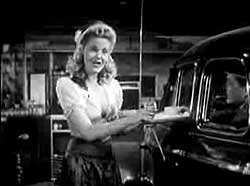 This cavalcade of sexism continues with At Your Service. A young man is singing about girls who bring you food right in your car & how you can date them; he comes off as a pimp only pretending the girls are waitresses as a ploy to evade arrest. This cavalcade of sexism continues with At Your Service. A young man is singing about girls who bring you food right in your car & how you can date them; he comes off as a pimp only pretending the girls are waitresses as a ploy to evade arrest.
The lyrics promise: "Large & small in every size/ Some of dumb & some are wise/ We don't have to advertise/ That we're always at your service."
A girl trio picks up the song, dressed as car hops: "In uniforms so neat/ Each one demure & sweet/ What we serve will be a treat/ Here's a place to eat." Double entandre intended.
Another couple verses (of several) run: "So, everytime you make a call/ Your tips may be large or small/ Sometimes there are none at all/ Still we're always at your service./ When you travel near or far/ Drive up in your motor car/ You can sit right where you are," & so on, some of it amusing, the only really endearing number of the set of three.
When the girls start tapdancing on the hood of the cars, while the much older guys crane their necks to look up their miniskirts, I thought, good for you gals, scratch up those burlesque hounds' cars good!
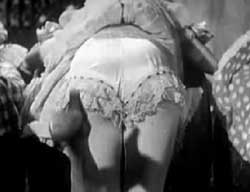 The third soundie is Playmates & it starts out innocently then gets perverse. Two girls & a swishy guy are singing an up-tempo tune about friendship to convince a young mother to come down from her apartment to join them. The third soundie is Playmates & it starts out innocently then gets perverse. Two girls & a swishy guy are singing an up-tempo tune about friendship to convince a young mother to come down from her apartment to join them.
She can't come out to play, as she has a baby to care for. The guy in the trio sings, "Oh, she couldn't come out & pay/ It was a sunny day."
These adult women are shown in childish dresses playing jacks, blocks, maypole, rolling in the grass together, & putting their heads in a row of buckets in order to show all their frilly undies, then sliding down a rootcellar door with their legs spread invitingly.
So it's one of the more pervy soundies, but the song's moderately all right, & it's amusing the guy dancing with the baby-acting girls is just so butt-swingingly gay.
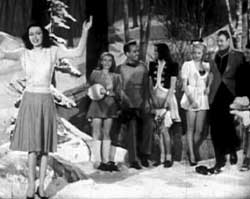 Felice Ingersoll's only soundie is Woo Woo (1943), sung on a stage decked out as a snowy winter scene beside a frozen pond. Felice Ingersoll's only soundie is Woo Woo (1943), sung on a stage decked out as a snowy winter scene beside a frozen pond.
Soundies weren't ordinarily holiday-specific because the panoram jukeboxes sought more than seasonal play.
Even when they shot winter scenarios, they avoided too many specifics of Christmas, & of all the soundies ever made, probably only two were Christmas carols per se. But a few films like Woo Woo brush up against the notion of, at least, secular holiday soundies.
In 1943 Felice was at the begnining of an attempted acting career but seems to have found her way into very, very few films with almost meaningless bit roles.
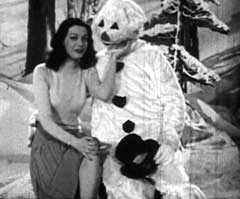 She was also turning out for audition for stage performances but was lucky if she got chosen to stand in back with a chorus line. That left this soundie as one of her bigger roles. She was also turning out for audition for stage performances but was lucky if she got chosen to stand in back with a chorus line. That left this soundie as one of her bigger roles.
It's pretty obvious why she didn't become well known as a singer, as she can't sing. But the song doesn't call for being sung well:
"I am feeling funny & I fret/ Things I should remember I forget/ I don't think I'm wrong to tell you/ Maybe you can tell me what to do/ I'm feeling funny all over, & it's not because I'm blue/ It's this kind of a feeling, woo-woo woo-woo woo-woo..."
Felice is pretty to look at but man she sucks as a singer. She's trying to do a Betty Boop flapper thing but is failing. Still, the soundie does get funny when out comes a guy in a snowman suit & tries to fondle Felice. The group of couples nearby include several girls wearing way too little for winter.
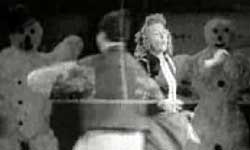 On a stage tricked out as a winter scene, with a man & woman building respectively a snowman & a snow-woman, they begin singing the agregiously bad novelty song The Little Snowman (1941) written by Nat Simon & Roy Newell.
On a stage tricked out as a winter scene, with a man & woman building respectively a snowman & a snow-woman, they begin singing the agregiously bad novelty song The Little Snowman (1941) written by Nat Simon & Roy Newell.
It begins with the two singers taking time with the lyrics: "You're the little snowman. You're the little snow lady," & it's all down hill from there. These tepid singers of a mediocre song are LaVerne Higham & Howard Anthony who were never particularly well known.
For a bit, there's some really lame trick photography of the "ghosts" or spirits of the snowman & snow-woman appearing as transparent dancers. Dancing snow-people spirits might have some appeal for kids if they can stand the music.
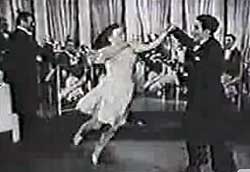 For climax, the snow-couple have a snow-baby, the "little snowman" of the title. The dancers playing the snowpeoples' spirits are billed as the Burton Twins, so the intimation that they might reproduce together is incestuous. For climax, the snow-couple have a snow-baby, the "little snowman" of the title. The dancers playing the snowpeoples' spirits are billed as the Burton Twins, so the intimation that they might reproduce together is incestuous.
Maharaja (1943) is one of those three-minute soundies that should be called a "dancie," starring a dance couple quite well known in their day, Hal & Betty Takier.
They perform a particularly lively jitterbug known as "balboa swing." But being dressed in their Sunday best for church, they don't look particularly hip, though very acrobatic about it
They are at moments being deliberately funny, like when Betty gets a piggyback ride round the dance floor. They're backed up by a great band which didn't get any credit on the opening credits card.
copyright © by Paghat the Ratgirl
|
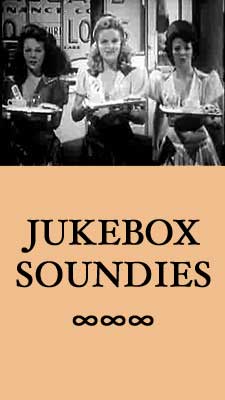

 Throughout the love tune, a beautiful woman sitting on the edge of the stage in front of the orchestra gives moony gazes at Sullivan. She is Niela Goodelle, who was separately excerpted from the same short subject to get a second soundie, Ten Pretty Girls; aka, Soundie M (1941). There is more excerpt from Air Parade which became Radio Parade (1943), featuring Niela Goodelle.
Throughout the love tune, a beautiful woman sitting on the edge of the stage in front of the orchestra gives moony gazes at Sullivan. She is Niela Goodelle, who was separately excerpted from the same short subject to get a second soundie, Ten Pretty Girls; aka, Soundie M (1941). There is more excerpt from Air Parade which became Radio Parade (1943), featuring Niela Goodelle.
 This cavalcade of sexism continues with At Your Service. A young man is singing about girls who bring you food right in your car & how you can date them; he comes off as a pimp only pretending the girls are waitresses as a ploy to evade arrest.
This cavalcade of sexism continues with At Your Service. A young man is singing about girls who bring you food right in your car & how you can date them; he comes off as a pimp only pretending the girls are waitresses as a ploy to evade arrest. The third soundie is Playmates & it starts out innocently then gets perverse. Two girls & a swishy guy are singing an up-tempo tune about friendship to convince a young mother to come down from her apartment to join them.
The third soundie is Playmates & it starts out innocently then gets perverse. Two girls & a swishy guy are singing an up-tempo tune about friendship to convince a young mother to come down from her apartment to join them.
 She was also turning out for audition for stage performances but was lucky if she got chosen to stand in back with a chorus line. That left this soundie as one of her bigger roles.
She was also turning out for audition for stage performances but was lucky if she got chosen to stand in back with a chorus line. That left this soundie as one of her bigger roles.
 For climax, the snow-couple have a snow-baby, the "little snowman" of the title. The dancers playing the snowpeoples' spirits are billed as the Burton Twins, so the intimation that they might reproduce together is incestuous.
For climax, the snow-couple have a snow-baby, the "little snowman" of the title. The dancers playing the snowpeoples' spirits are billed as the Burton Twins, so the intimation that they might reproduce together is incestuous.